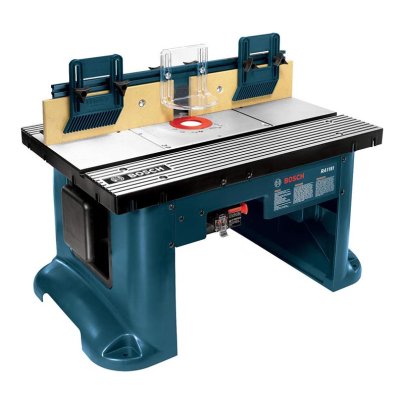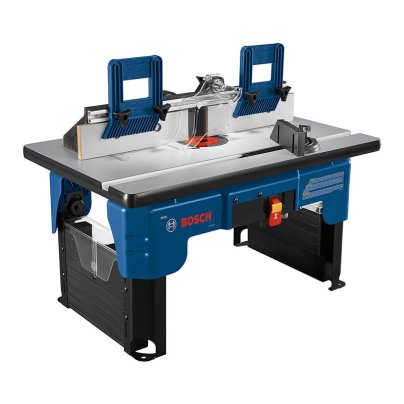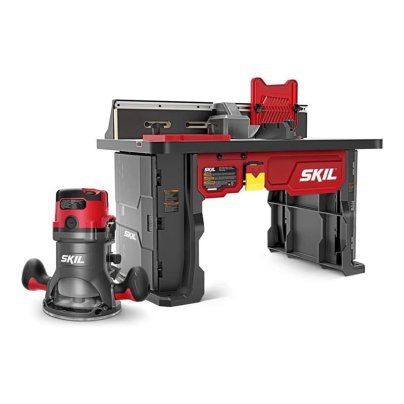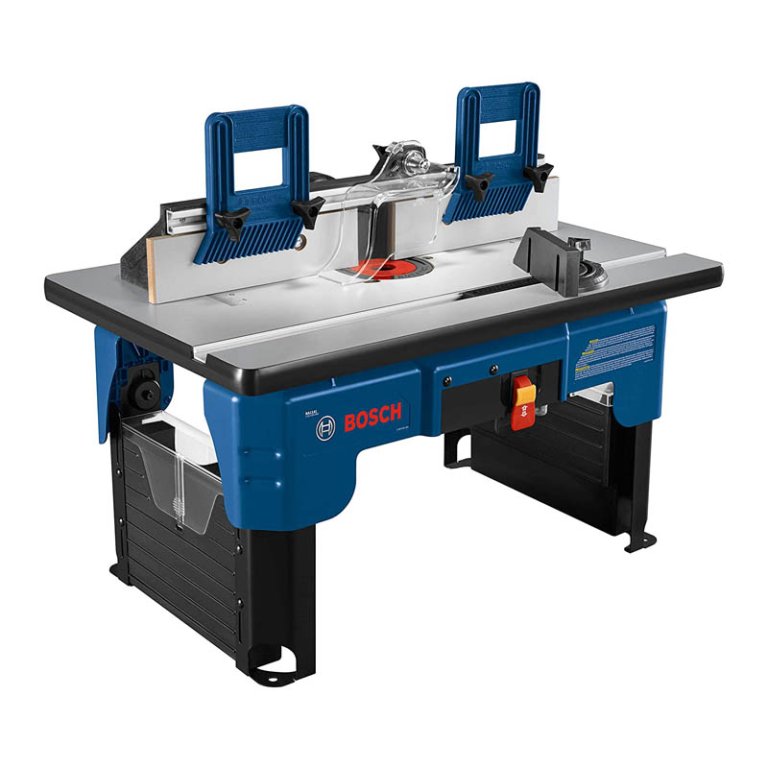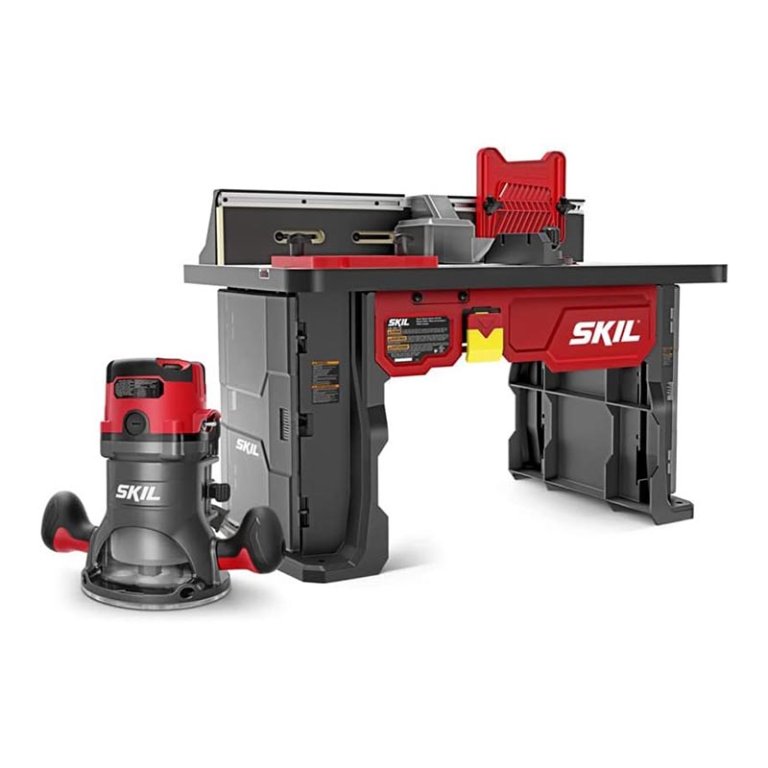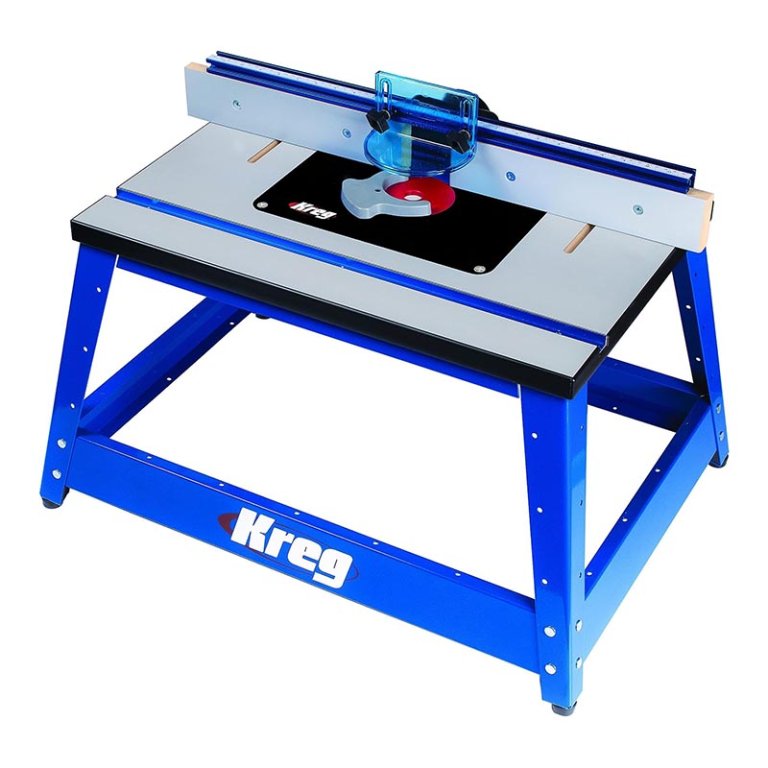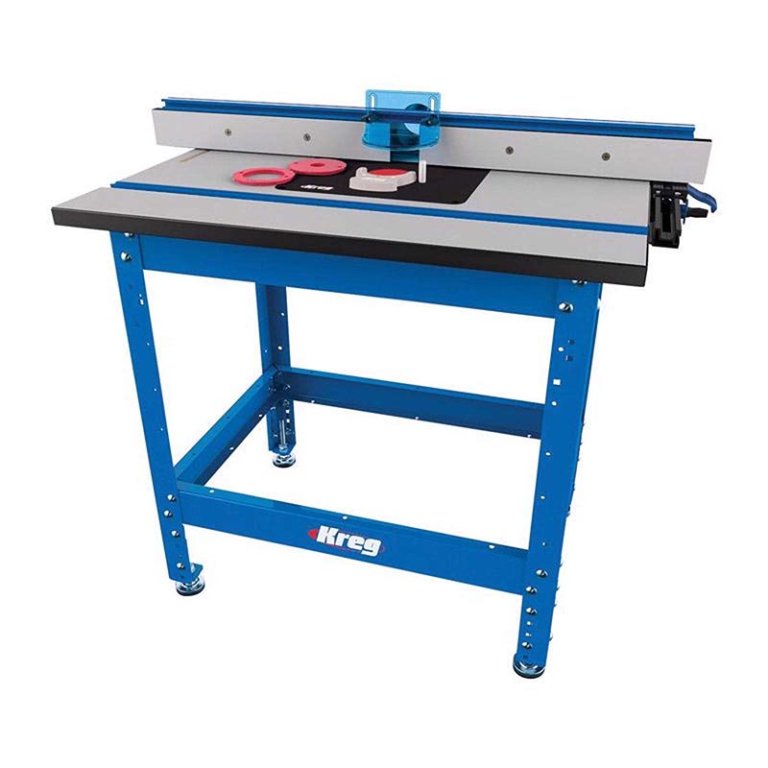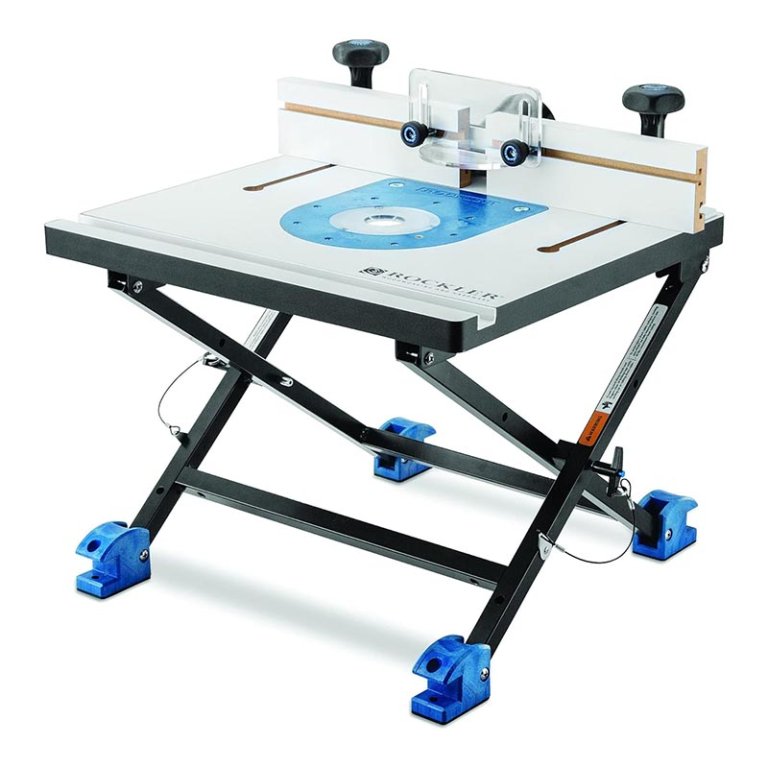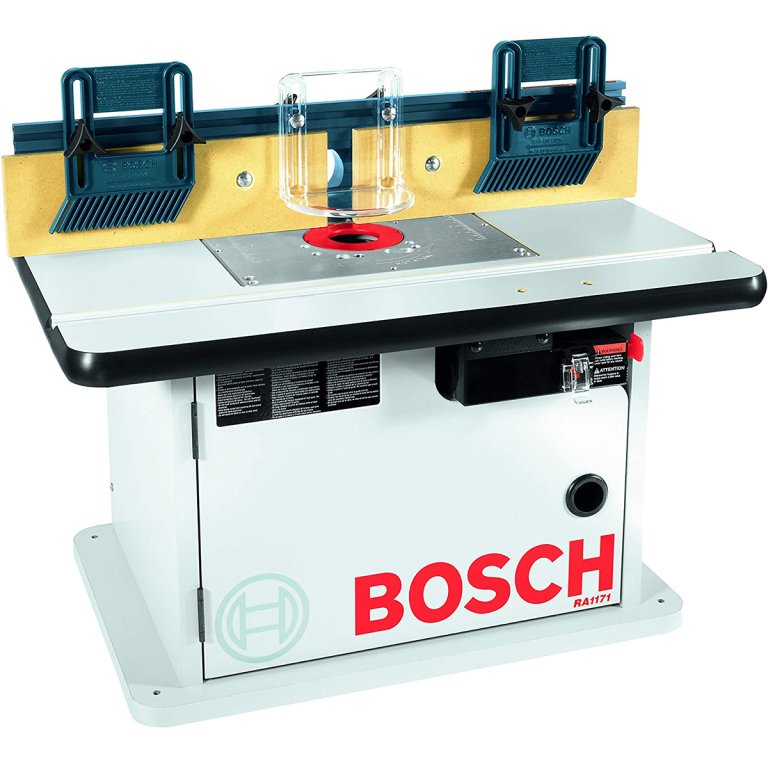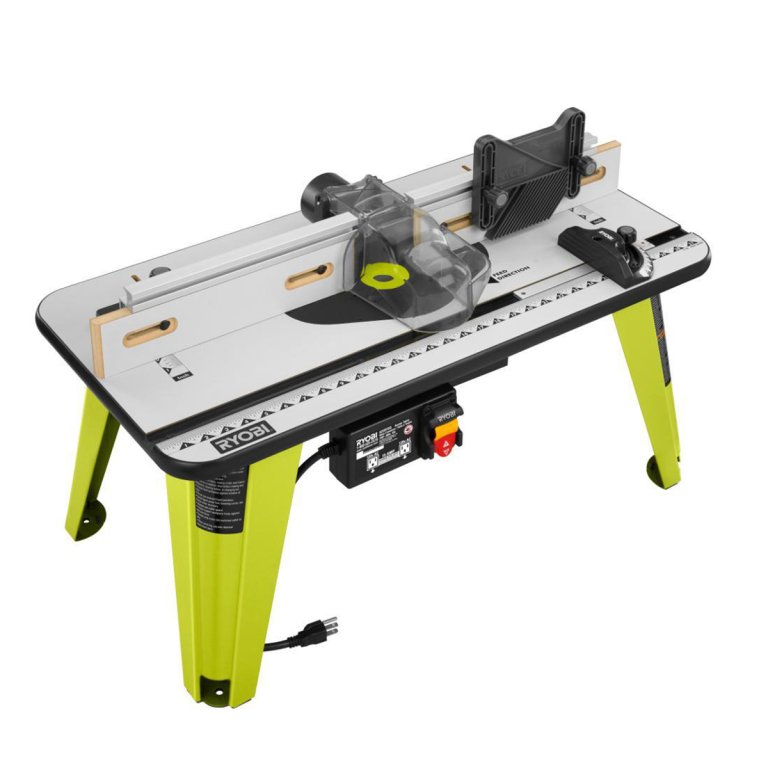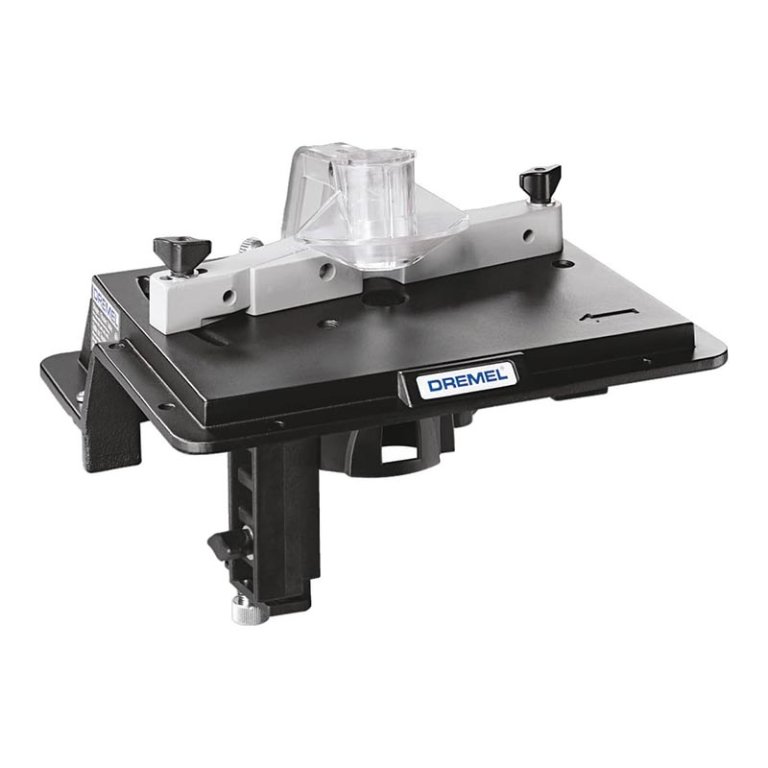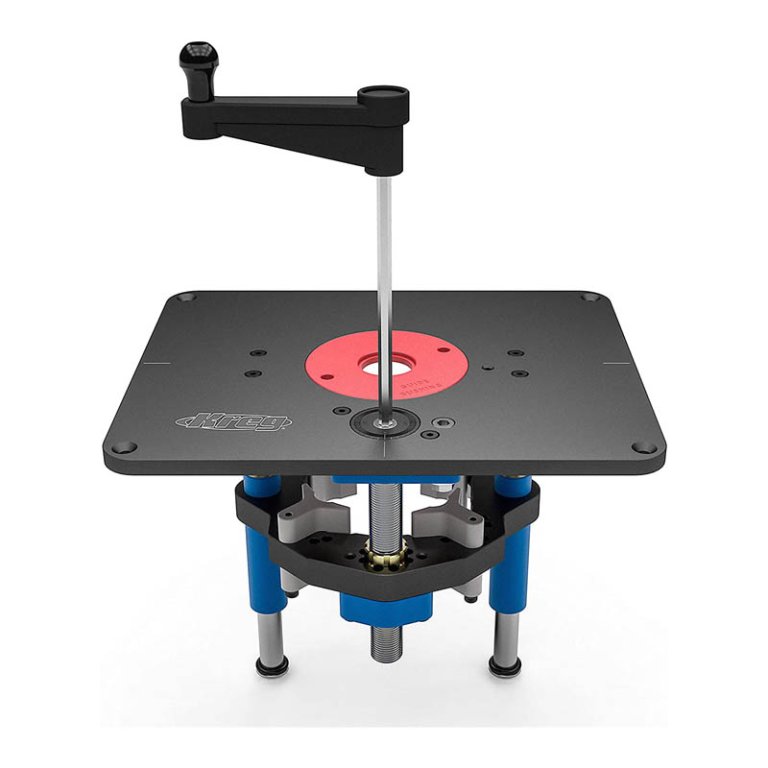
We may earn revenue from the products available on this page and participate in affiliate programs. Learn More ›
While handheld routers allow users to create decorative details, joinery, and many other embellishments in the wood shop, they do have limitations. For starters, they’re heavy. They require two hands to operate, which limits their use to larger stationary objects. But with a router table, you can securely mount the router to a table, freeing your hands up to better control the workpiece. By adding the best router table to your workshop, you can take your woodworking to a new level without purchasing yet another power tool.
With a router table, woodworkers can accomplish various carpentry tasks, including molding, flattening, squaring edges of boards, and routing precise cuts freehand into small pieces of wood. Different router tables offer these capabilities with varying degrees of portability, adjustability, and durability. Prices vary quite a bit as well. We’ve tested an assortment of tables that fulfill different performance needs and budgets. After 3 days of extensive hands-on testing, we reviewed the following models. If you’re in the market for a new router table, perhaps one of these router tables will be the right one for you.
- BEST OVERALL: Bosch RA1181 Benchtop Router Table
- BEST BANG FOR THE BUCK: Bosch RA1141 Portable Benchtop Router Table
- BEST KIT: Skil Router Table and Fixed Base Router Kit
- BEST BENCHTOP: Kreg PRS2100 Precision Benchtop Router Table
- BEST FREESTANDING: Kreg PRS1045 Precision Router Table System
- BEST PORTABLE: Rockler Convertible Benchtop Router Table
- BEST CABINET: Bosch RA1171 Cabinet-Style Router Table
- BEST UNIVERSAL: Ryobi Intermediate Router Table
- BEST MINI: Dremel 231 Shaper Router Table
- BEST LIFT: Kreg PRS5000 Precision Router Lift

How We Tested the Best Router Tables
We began by researching the most popular router table brands and models sold by nationwide tool retailers. We considered the different needs that router tables fulfill for woodworkers and builders, and we noted the attributes that make certain models stand out for specific purposes. Ultimately, we brought in 10 different router tables for testing.
We assembled the tables, installed the routers, and leveled the baseplates, then mounted the tables to a benchtop for operation. Setup observations were an important part of our testing process, as this phase reveals a lot about product quality.
Next, we moved on to operation. We selected two sizes of test stock: 12-inch-long by 4-inch-wide pieces of ¼-inch-thick plywood and 4-foot lengths of 2×8 pine lumber. We performed three test cuts on each table for each type of test stock. The first pass was an edge roundover. The second pass was a dado. The final pass was a groove.
Throughout testing, we assessed each router table’s performance by evaluating various criteria, including the stability of the base during operation, vibration transfer from the router motor to the workpiece, ease of making basic adjustments, precision and security of the adjustments, and repeatability of the cuts. We recorded our observations and scored each model according to ease of use, stability, and portability, as well as our perception of each table’s quality and value.
Testing Stats
Products Tested: 10
Hours Spent Testing: 21
Tests Performed: 6
Average Price: $241.57
Our Top Picks
We tested some of the best router tables from the market’s top manufacturers. After spending 3 days assembling these tables, installing our routers, adjusting, routing, adjusting again, and routing even more, we’re excited to share our observations. Read on to find a model suitable for your projects.
Best Overall
Bosch RA1181 Benchtop Router Table
Pros
- Durable aluminum tabletop with aluminum plate and fence for long-term durability
- Sturdy base with cord wrap and tool pocket for more organized storage
- Ready-to-use kit includes throat plates, featherboards, bit guard, and vacuum port
- Compatible with a wide variety of popular router brands and models
Cons
- Compared to other models we tested, this one required a little longer to level the baseplate
- The metal top and plastic legs make the unit feel top-heavy
Product Specs
- Type: Benchtop
- Size: 27 inches long by 22.75 inches wide by 14.5 inches high
- Fence type: Single
Our Ratings: Ease of Use 4.5/5; Stability 4.5/5; Quality 4.5/5; Portability 5/5; Value 4.5/5
The Bosch RA1181 offers an excellent combination of durability, adjustability, precision, and value. It is equipped with an aluminum tabletop, baseplate, and fence that provide a perfectly flat surface with zero movement caused by temperature and humidity fluctuations. The kit comes with medium-density fiberboard (MDF) faceplates for the fence, along with an assortment of throat plates, two featherboards, a bit guard, and a vacuum port. It also includes a power switch with two outlets to accommodate a router and vacuum. This router table is compatible with most of the popular router brands and models.
Unlike the aluminum tabletop, the table legs are made of molded plastic. The table is equipped with a cord wrap on one end and a tool pocket for organizing bits and spare parts on the other. The base offers four predrilled holes for screw mounting the router table to a benchtop. Alternatively, the feet can be clamped in place.
It took us about an hour to assemble and mount the RA1181 router table and another 30 minutes to install the router and level the baseplate. The instructions were adequate. While researching this unit, we noted several reviewer complaints that hinted toward a complicated assembly, difficulty leveling the base, and a tabletop that was not truly flat. We experienced none of those issues. It was simply a matter of “assemble the tool and get to work.” We were very pleased with the results.
Once securely mounted on the bench, the table was completely stable during operation. The fence adjustments worked as designed. The accessories provided everything needed to safely operate the equipment. The only potential weak point was the power switch, which felt kind of flimsy, although we didn’t experience any malfunctions because of it.
Read our full review: Bosch RA1181 Benchtop Router Table
Get the Bosch RA1181 router table at Amazon, Lowe’s, or The Home Depot.
Best Bang for the Buck
Bosch RA1141 Portable Benchtop Router Table
Pros
- Sturdy benchtop design with folding legs for easy transport and storage
- Storage compartments built into the legs for router bits and spare parts
- Fast and easy click-mounting system automatically levels the router
- Kit includes 2 adjustable featherboards, starter pin, throat plates, and miter gauge
Cons
- Must be mounted with clamps or screws to prevent unwanted movement while working
Product Specs
- Type: Benchtop
- Size: 26 inches long by 16.5 inches wide by 14.5 inches high
- Fence type: Split
Our Ratings: Ease of Use 4.5/5; Stability 4/5; Quality 4.5/5; Portability 5/5; Value 5/5
With its sturdy construction, portable design, and wide variety of additional features, this Bosch benchtop router table is a worthy addition to any home workshop. It features an ample 26-inch-long by 16.5-inch-wide workspace, which can capably handle boards up to 6 or 7 feet long. Its 1-inch-thick laminated MDF top provides a sturdy work surface. The tall fence with two adjustable featherboards serves as a secure guide when running material through the router. The baseplate uses a click-mounting system that attaches to the router in seconds, and it’s compatible with routers from most major tool brands, including Craftsman, DeWalt, Hitachi, Ryobi, Milwaukee, Makita, and Bosch. A T-slot runs the length of the table and works with the included miter gauge. This table has bins integrated into its legs for storing extra bits and baseplates. Foldable legs make this 33-pound router table portable.
The Bosch RA1141 router table was one of the most affordable and easiest to set up in the entire test group. We appreciated that it came with everything needed to get started on basic projects: throat plates, adjustable featherboards, and a miter gauge. Although the click-mounting system was less precise than some of our top performers, it worked well for production projects like edge shaping; still, it is not ideal for projects with tight tolerances. To prevent unwanted leg movement during operation, this table must be clamped or screwed down to the benchtop.
Get the Bosch RA1141 router table at Amazon or The Home Depot.
Best Kit
Skil Router Table and Fixed Base Router Kit
Pros
- Affordable price point for a complete router table kit including router
- Kit includes a fixed-base router and benchtop router table
- Tall fence with MDF faceplates and aluminum accessory track for improved control
- Storable, portable router table with onboard tool and bit storage
Cons
- Leveling and adjustments are not as precise as some of the other router tables we tested
- Lightweight base with slight wobble in the legs while feeding larger workpieces
Project Specs
- Type: Benchtop
- Size: 26 inches long by 16 inches wide by 18 inches high
- Fence type: Single
Our Ratings: Ease of Use 4.5/5; Stability 4/5; Quality 4.3/5; Portability 4/5; Value 5/5
This router table and fixed-base router combo from Skil is a convenient and affordable package that’s especially appealing for router table beginners. The table features a sturdy work surface made of laminated MDF, a metal router mounting plate with a quick-attachment bracket, onboard storage for bits and tools, and a tall fence that works well with bulkier workpieces. The included router has a 10-amp motor, soft-start switch, and a variable-speed controller to accommodate bits of different types and sizes.
Although some assembly was required, this was one of the easier tables to set up. Altogether, attaching the legs, assembling and attaching the fence, and installing and adjusting the router took about 30 minutes. Not every router table in our test group included its own power switch, but this one includes a dual outlet paddle switch for safe and convenient power control. The lightweight legs on the table necessitate clamping or screwing the unit to the benchtop. Even with that done, we experienced a slight wobble while feeding larger and heavier work pieces.
As with some of the other budget-friendly models, this table and mounting system was not the best at precision work but functioned well for edge shaping and other tasks with wider tolerances. We really liked the router, too. It provided plenty of power to efficiently drive large and small bits, even in hardwood.
Get the Skil router table at Amazon or Woodcraft.
Best Benchtop
Kreg PRS2100 Precision Benchtop Router Table
Pros
- Full-size standard insert plate with drilling schematic accommodates various popular routers
- Heavy-duty steel legs with nonslip rubber feet ensure a sturdy working surface
- Miter track, locking throat plates, and adjustable extruded-aluminum fence included
- Laminated MDF tabletop with durable Microdot skin reduces vibration
Cons
- More expensive compared to most of the other router tables we tested
- Does not include common accessories such as featherboards or power switch
Product Specs
- Type: Benchtop
- Size: 24 inches long by 16 inches wide by 16 inches high
- Fence type: Single
Our Ratings: Ease of Use 4.5/5; Stability 5/5; Quality 4.5/5; Portability 4/5; Value 4.5/5
When it comes to the best router tables, quality construction and materials make all the difference. Kreg’s benchtop router table has a laminated MDF tabletop supported by wide-stance, heavy-duty steel legs. A full-size phenolic insert plate supports even the largest routers and has integrated levelers for fine-tuning. Multiple rings enable proper bit sizing. Other notable features of the Kreg PRS2100 are its aluminum miter gauge slot, adjustable extruded-aluminum fence, and dust-collection system. Those who are sensitive to router noise can enclose the router via predrilled holes in the table’s base.
We really liked the simple, sturdy design of the Kreg router table. The steel stand was easy to assemble and very sturdy, and we liked the laminated MDF top, which features a friction- and vibration-resistant textured surface. Setting up the router required drilling, but we followed one of several predrawn schematics on the underside of the baseplate, and it was not difficult to get it right. This setup is truly universal in that users can customize the baseplate if their router does not match up with any of the schematic patterns.
Once assembled, using the table was a mostly pleasant experience. We would have liked it to include a switch plate, which Kreg sells separately. As it was, we reached under the table to control the power with the tool’s switch. Adjustments were easy to make and secure, but we borrowed a set of featherboards from another unit to help control the feed. This was a really nice basic table, but it lacked several important accessories. Still, Kreg’s benchtop router table is an excellent option for those who can swing its steep price tag.
Get the Kreg PRS2100 router table at Amazon or Woodcraft.
Best Freestanding
Kreg PRS1045 Precision Router Table System
Pros
- Extra-large laminated MDF router table with vibration-reducing surface skin
- Adjustable-height heavy-duty shop stand with leveling feet; also works with casters
- Tall fence with MDF face and precision adjustment capability
- Rigid baseplate includes drilling templates for various popular router models
Cons
- Large, costly, and not portable; limited practicality for all but the largest projects
- The threads sheared off inside one of the fence bracket bolt holes during assembly
Product Specs
- Type: Freestanding
- Size: 32 inches long by 24 inches wide by 31 to 39 inches high (height adjustable)
- Fence type: Single
Our Ratings: Ease of Use 4.4/5; Stability 5/5; Quality 4.5/5; Portability 3/5; Value 4/5
Serious hobbyists and professional woodworkers in need of a full-time workshop router table will appreciate the size, stability, and adjustability of the Kreg PRS1045. It comes with a heavy-duty steel base with an adjustable height between 31 and 39 inches. The base is equipped with feet and can easily be upgraded with heavy-duty casters. The laminated MDF router tabletop measures 32 inches long by 24 inches wide and includes an aluminum miter track and a precision insert plate system. Lastly, the large extruded-aluminum fence features a T-square precision adjustment system and fast, secure twist-locking mechanisms.
Assembling the Kreg precision router table didn’t take much longer than the benchtop models. Well organized, the parts were separated into three boxes: one each for the base, tabletop, and fence. Everything went smoothly until we attached the fence to the bracket on the tabletop, which involved steel bolts threading into aluminum threads. One of the bolts apparently cross threaded and sheared the threads completely out of one hole. We were able to get by with the remaining attachment points, but this is something that (1) users will want to be aware of, and hopefully (2) Kreg will address by improving this connection point.
Aside from that mishap, working with the Kreg PRS1045 system felt like a luxury. The table height was perfect, and the broad surface offered ample space for bigger project pieces. After initial calibration, the fence remained perfectly square. The fence and table adjustments were easy to make and held strong. As with the smaller Kreg table, we had to borrow featherboards and a miter gauge from other equipment around the workshop to complete our tests because they were not included. Again, it would be nice to have a power switch, but that accessory is sold separately.
Get the Kreg PRS1045 router table at Ace Hardware or US Tool and Fastener.
Best Portable
Rockler Convertible Benchtop Router Table
Pros
- Lightweight folding router table is the most portable of all the models we tested
- Can be used in either a wall-mounted or bench-mounted configuration
- Works with several different baseplates for different applications
- Compatible with a variety of popular router brands and styles
Cons
- Lightweight steel frame and small tabletop are only suitable for small to midsize pieces
- More expensive than some of the sturdier benchtop models we tested
- Router insert plate is sold separately
Product Specs
- Type: Benchtop/wall mount
- Size: 18.5 inches long by 16.375 inches wide by 19 inches high (in benchtop mode)
- Fence type: Single
Our Ratings: Ease of Use 4/5; Stability 4/5; Quality 4/5; Portability 5/5; Value 3.5/5
For smaller wood shops or users who need a higher degree of portability, the Rockler convertible benchtop router table is tough to beat. This lightweight router table features a unique folding design that makes storage and transport super easy. It can be wall- or bench-mounted for space-saving efficiency. Rockler’s folding router table comes with an MDF tabletop and an adjustable fence. The router insert plate is sold separately.
This table required assembly, which took about 30 minutes to complete. We attached the feet, fastened the locking pin retainers to the legs, and assembled the fence. It’s important to note that the table does not come with a router mounting plate. That’s an additional purchase, which seemed a bit odd. Other units simply offered a plate with multiple screw hole options or drilling templates, which was much more convenient.
Once assembled, the Rockler folding router table worked as advertised. We clamped it to a benchtop for a few cuts, then moved it to a wall-mounted position for a few more cuts. The best and most unique aspect of this table is its lightweight portability. It worked pretty well for small pieces, but the small tabletop was impractical for larger and heavier project pieces, which was to be expected. It was sturdier than we had anticipated, but it did wobble a bit. Adjustability was fairly basic but effective.
To us, it felt like a strong option for occasional use on craft projects but perhaps not for frequent, intensive use.
Get the Rockler router table at Amazon or Rockler.
Best Cabinet
Bosch RA1171 Cabinet-Style Router Table
Pros
- Sturdy cabinet storage base is an exceptionally solid platform for routing
- Kit includes key accessories: jointing shims, featherboards, throat plates
- Sturdy aluminum mounting plate, fence, and T-track miter slot
- Tall fence with MDF faceplates, T-track for featherboards, and jointing shims
Cons
- More complicated assembly than most of the other models we tested
- Unnecessary proprietary hardware and awkward spacing of the fence accessory track
Product Specs
- Type: Benchtop
- Size: 25.5 inches long by 15.875 inches wide by 14.5 inches high
- Fence type: Single
Our Ratings: Ease of Use 4/5; Stability 5/5; Quality 4.5/5; Portability 4/5; Value 5/5
You won’t have to worry about dust if you choose this cabinet-style router table from Bosch, which contains two dust-collection ports to keep the workshop sawdust-free. The sturdy MDF table also comes with two easy-to-use featherboards, which provide extra guidance and protection against kickback and are fully adjustable to fit a variety of workpieces. This cabinet-style router table’s large laminated workbench top utilizes a rigid cast aluminum mounting plate, which is predrilled for use with many popular routers and allows you to make above-table height adjustments.
Other reasons this router table is worthy of consideration? It has a large aluminum fence, a dual-outlet power switch, and it can be mounted to a workbench with clamps or screws via four predrilled holes. The cabinet offers additional storage space for router bits and accessories.
Assembling this table took a little longer than others we tested—in part because of the fully enclosed cabinet base, but also due to a few odd connection points. The tool track on the fence, in particular, requires spacers for attached tools to align with the fence faces below. We found this detail unnecessarily cumbersome. Once assembled, however, this was one of the sturdiest benchtop models. Adjustments to the router and fence were easy to make and secure once set.
Get the Bosch RA1171 router table at Amazon, The Home Depot, or Acme Tools.
Best Universal
Ryobi Intermediate Router Table
Pros
- Universal baseplate works with all major router brands
- Large workspace with affordable and dependable laminated MDF construction
- Includes 5 throat plates to accommodate a wide variety of router bits
- Built-in vacuum port is compatible with most workshop vacuum brands
Cons
- Fence faces were not perfectly flat and flush with one another
Product Specs
- Type: Benchtop
- Size: 32 inches long by 16 inches wide by 18.25 inches high
- Fence type: Single
Our Ratings: Ease of Use 4/5; Stability 4/5; Quality 4.5/5; Portability 4/5; Value 4.5/5
Your router table will only be as good as its ability to work seamlessly with your router. Ryobi’s table works with all major router brands, including some older brands and models. In addition to diverse compatibility, this table offers good general-purpose durability and performance. A large laminated MDF worktop and sturdy metal legs provide a smooth and steady work surface. Other quality features include an adjustable fence, five different sizes of throat plates, and an aluminum T-track for mitered router cuts. An integrated power station on the Ryobi includes enough room for the router and a shop vacuum. To keep sawdust mess under control, this router table is outfitted with a built-in vacuum port that supports 1¼-inch and 2½-inch attachments.
The Ryobi router table’s fixed nonfolding base was sturdier than all of the folding bases we tested. For smaller pieces, it was not necessary to secure the table to the benchtop, but the feet were perfectly shaped for either clamps or screw-down fastening for added security. The large work surface was handy for working with longer, wider pieces—we had no trouble rounding over the edges of 6-foot-long 1×8 planks.
On the downside, the fence faces were not perfectly flat with one another, nor was the mounting plate perfectly flat. The variations were only fractional, but it would require extra effort and some creativity to achieve perfection.
Get the Ryobi router table at The Home Depot or Amazon.
Best Mini
Dremel 231 Shaper Router Table
Pros
- Compact, lightweight, and portable; can also be permanently mounted if desired
- Works with a variety of corded and cordless Dremel rotary tools
- Includes an adjustable guide fence and built-in clear plastic safety guard
- Budget-friendly price point for a mini routing and shaping table
Cons
- Plastic construction may be less durable than other options
- Only compatible with Dremel products
Product Specs
- Type: Benchtop
- Size: 8 inches long by 6 inches wide by 6 inches high
- Fence type: Single
Our Ratings: Ease of Use 4/5; Stability 4/5; Quality 3.5/5; Portability 5/5; Value 4.5/5
A Dremel rotary tool is handy for small craft projects, including routing and shaping small pieces. Measuring just 8 inches long by 6 inches wide, Dremel’s portable table might be the smallest router table on the market. This attachment can connect to a Dremel corded or cordless rotary tool and transform the device into a wood shaper. The Dremel 231 is made of durable and lightweight plastic, so it’s easy to store or carry to the worksite. This table mounts to a workbench with standard C-clamps, or you can permanently mount it with screws via premolded mounting holes. Other key features on this Dremel router table attachment include a fence for precision cuts and a plastic safety guard.
This portable router table does have one limitation: It is only compatible with Dremel corded and cordless models. After installing our Dremel tool into the table base and clamping the table to our benchtop, we were pleasantly surprised with the level of control this table provided. It only took about 3 minutes to set up, and we were able to change bits without disassembling the system. Our test pieces measured no larger than 12 inches long by 3 inches wide by ¼ inch thick, which seemed ideal for this system. The slotted thumb screws and plastic wing nuts made it fairly easy to assemble and make adjustments. There were no fixed benchmarks or measuring devices built into the table, so we had to use a T-square ruler to set up the fence accurately.
This is a nice little accessory that could make mini-routing projects a lot easier.
Get the Dremel router table at Amazon, Lowe’s, or The Home Depot.
Best Lift
Kreg PRS5000 Precision Router Lift
Pros
- Enables micro adjustments for projects where precision is critical to success
- Includes a carriage adjustment crank for easy above-table height changes
- Hard anodized aluminum router lift plate measures 11 ¾ inches long by 9¼ inches wide by ⅜ inch thick
- Enables easy above-the-table router bit changes
Cons
- High-quality precision router lift; more expensive than many complete router tables
- Not compatible with every router
Product Specs
- Type: Router lift
- Size: 11.75 inches long by 9.75 inches wide
- Fence type: No fence
Our Ratings: Ease of Use 5/5; Stability 5/5; Quality 5/5; Portability 4/5; Value 4/5
This Kreg router lift takes a router table to the next level by dramatically improving the baseplate’s precision and functionality. It can also serve as the core component of a custom-made router table for anyone building one from scratch. The lift holds the router body and makes micro height adjustments accurate to 1/1000 inch, allowing for precision router work. This lift also allows the operator to raise the collet high enough for bit changes above the table, so the router doesn’t have to be detached. With the adjuster handle at the top of the table, there’s no need to grope under the table to change the height of the bit. The router lift plate is compatible with Kreg router tables and many other router table brands.
Since the Kreg router lift is not a router table but a key component of one, we tested it on our Best Benchtop pick, the Kreg PRS2100 router table. To do so, we installed our router into the lift, removed the original baseplate from the router table, and inserted the PRS5000 in its place with the router attached. Leveling was easy. With the included mounting hardware and 8 leveling pins (which are included with the lift but are the same as those already installed on the Kreg router table), it only took about 2 minutes.
In operation, it was a game-changer compared to the mounting plates on all the other tables. This accessory is heavy duty and adjusts precisely with repeatable results. We especially liked the convenience of making adjustments and changing bits above the table, which saved a ton of time.
Get the Kreg PRS5000 router lift at Amazon, The Home Depot, or Woodcraft.
Jump to Our Top Picks
What to Consider When Choosing a Router Table
While shopping for a router table, start by considering the size of your workshop and the brand of your router. Then, decide what you’ll need in terms of the table’s size, portability, material, and baseplate style, and make sure the router tables you’re considering are compatible with your router. Read on to learn about these and other considerations.
Freestanding vs. Benchtop
Many users prefer freestanding router tables over benchtop router tables, and with good reason. Freestanding tables typically have sturdy bases and large worktops that can accommodate longer, wider boards. Their downside is that they’re heavy, which makes them difficult to transport to worksites.
Most freestanding router tables measure approximately 32 inches long by 24 inches wide, but benchtop router tables are typically smaller, measuring approximately 24 inches long by 16 inches wide. As a result, they can’t accommodate the same size boards that larger freestanding router tables can. As their name implies, benchtop router tables also require a workbench for support and are not as stable as single-unit freestanding models. The upsides to benchtop routers are that they’re more compact and weigh less, so they’re more portable than freestanding models.
Size
The size of a router table directly correlates with how large of a workpiece it can accommodate. Router table work surfaces range in size from about 22 inches long by 16 inches wide at the smaller end of the spectrum to 36 inches long by 24 inches wide on the larger end. A 22-inch to 36-inch router table can support boards up to 8 feet long. Likewise, a wider table will provide better support for wider boards.
Material
A router table can be made of various materials, and the materials used will have a big impact on the table’s cost and durability. MDF, which is rigid and strong, is the most popular material for router tabletops. An MDF top should be at least 1 inch thick so that it’s sturdy enough to serve as a work surface. MDF tops with melamine coatings are preferred because a melamine coating will protect the wood from moisture and impact. Exposed MDF will soak up water like a sponge and puff up, ruining the work surface.
Some MDF tables have a high-pressure laminate (HPL) surface, which layers protective resins with a melamine work surface for additional strength. A router table with HPL on both sides is a great choice for most users because it is more likely to stay flatter for longer.
Phenolic resin is an even higher-grade material than MDF. Phenolic resin is thinner than MDF, won’t be damaged by water, and should maintain its shape for the lifetime of the table. Phenolic resin router tables are among the most expensive models one can buy.
Metal router tables are high-end as well. Cast aluminum provides a sturdy, durable worktop that will maintain its shape. Pro-shop router tables, which are the most premium tables on the market, have a cast-iron work surface. There isn’t a router table material that’s flatter, more stable, and more durable than cast iron.
Router Compatibility
The best router tables will often come equipped with multiple baseplates to complement different router hole patterns, making them compatible with most routers from major tool brands. It’s best to avoid router tables that have universal-design baseplates. The number of holes in these plates can compromise their structural integrity—and create places for dust to accumulate.
Mounting Plate
Each router table has a mounting plate, also known as a baseplate, that fits into a hole in the tabletop. As the name suggests, the router mounts on this plate. Since this plate must support the weight of the router while remaining perfectly flat, it’s crucial that it’s constructed of solid, sturdy material, such as aluminum or phenolic resin. The mounting plate must also be compatible with the router. It should have mounting holes that align with the holes on the router.
Since it’s crucial that the plate sits flush with the router table, a good router table will have a plate-leveling system. This consists of four or more leveling screws that allow the user to adjust the level accordingly. It’s also important to consider how easily the plate can be put into place. A professional router table with a mounting plate that’s difficult to install won’t work for those who plan to use the router with and without the table.
Miter and T-Slots
Most router tables have a T-slot on their surface that allows for the use of a miter gauge and other accessories. A miter gauge holds workpieces at an angle while they are cut, and it has an adjustable router table fence that the operator can set to virtually any angle.
The miter gauge is attached to a long metal guide that slides through a T-slot, which is a long groove that runs the length of the table. Though the fence will get the lion’s share of work on a professional router table, there will be occasions that call for a miter gauge.
Fence
An easy-to-use, adjustable fence is critical on a router table. In most situations, the router’s operator will guide the material through the router blade by pushing it up against the fence. Whether the router table fence is made of wood or metal, it should be sturdy. When making precise router cuts, it’s important to have a solid base against which the operator can push the workpiece.
There are two types of fences on router tables: single-piece fences and split fences. Split fences made of two pieces are more versatile than single-piece fences, as they allow the user to set the infeed at a different level than the outfeed. With this kind of fence, the router can execute complicated jointer cuts.
The downside is that it can be challenging to perfectly align a two-piece fence for regular cuts. A single piece won’t allow you to join the straight edge of a board, but alignment isn’t an issue if the router table fence is one solid piece from infeed to outfeed.
Additional Features
Many router tables have additional features that boost functionality and storage space, and some even help keep the workspace clean. Router lifts are devices that allow for micro adjustments of the bit height, enable easy bit changes, and offer easier-to-access lift handles. If the router table doesn’t have router lifts, they can be purchased as add-ons.
Those who like having all their accessories within easy reach will want to consider router tables that have convenient storage bins built into the body. This extra storage space is ideal for holding extra baseplates, miter gauges, and router bits. Routers with exhaust ports allow the user to hook up a hose that siphons sawdust off the table and into a waste container.
Tips for Using a Router Table
A router table adds a whole new world of functionality to a router, but it can be a little tricky to use at first. Read on for important tips regarding the proper use of a router table.
- Clamp it down. Portable router tables and benches use a benchtop or table for support. Before using a router bench, clamp it securely to the table or workbench to prevent it from sliding.
- Use featherboards to apply down pressure. Most people will use the fence as a backstop against which pressure can be applied to the board, but featherboards are just as important. These tools attach to the fence and apply down pressure to the board as it moves through the router bit. This prevents the board from lifting off the table under the pressure of the spinning router bit.
- Tighten all bolts. There are two critical connections to check before using a router: the collet and router base. The collet is the part that connects the bit to the router, holding the bit in place. Make sure the collet is tightly screwed to the router to prevent the bit from coming off while in use. Also, make sure the bolts holding the router to the table are tight so that the router stays in place while in use.
- Use a push block for end routing. Routing the end of a board will often cause the wood fibers at the end corner to splinter as the blade passes through them. Using a push block that fits flush to the end will solve this problem and keep the wood fibers intact, preventing chipping.
FAQs
If you’re still wondering which characteristics to look for in a quality router table, read on for answers to some of the most commonly asked questions.
The flattest, sturdiest, and most durable material for a router tabletop is cast iron. It’s also the most expensive and is therefore used only in professional shops. Cast aluminum and phenolic resin are the best affordable options for home woodshops.
A good MDF router table should be at least 1 inch thick to prevent sagging. However, some router tables made of high-quality materials can get away with being thinner than 1 inch. For example, a metal or high-quality resin tabletop can be thinner than 1 inch and still be sturdy, but MDF must be thicker to resist bending.
Most router tables include multiple baseplates that accommodate all major brands of routers. It’s important to check a specific table’s list of compatible routers before purchasing it.
A plunge router can be used on a router table and is just as safe as a fixed-base router.
Begin by attaching the router to the baseplate of the router table using the mounting screws. For a freestanding table, once the router is installed, it’s ready for action. A benchtop router table requires a steady base. Set the benchtop router table on a sturdy workbench or table, and use clamps to fasten the router base to the table securely to prevent it from sliding while in use.
Meet the Tester
Mark Wolfe is a product tester and writer with an extensive background in the nursery and landscaping industry. He kept his tool box well stocked in order to build or repair fences, walls, irrigation systems, and equipment on any given day. Now he tests and writes reviews about the latest hand tools, lawn care products, outdoor power equipment, and other outdoor-living goods.
Additional research provided by Tony Carrick.
